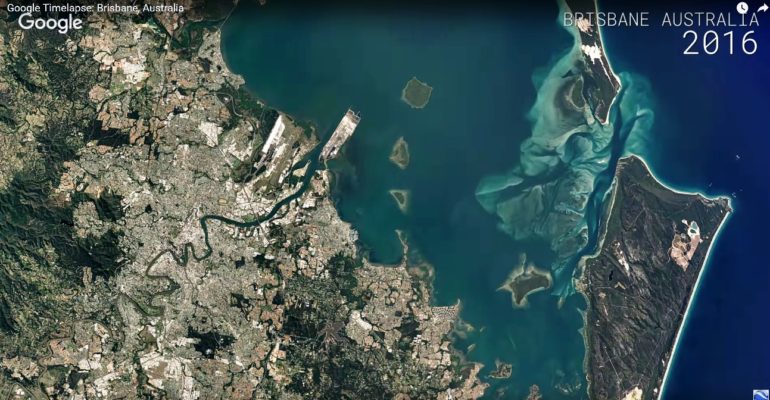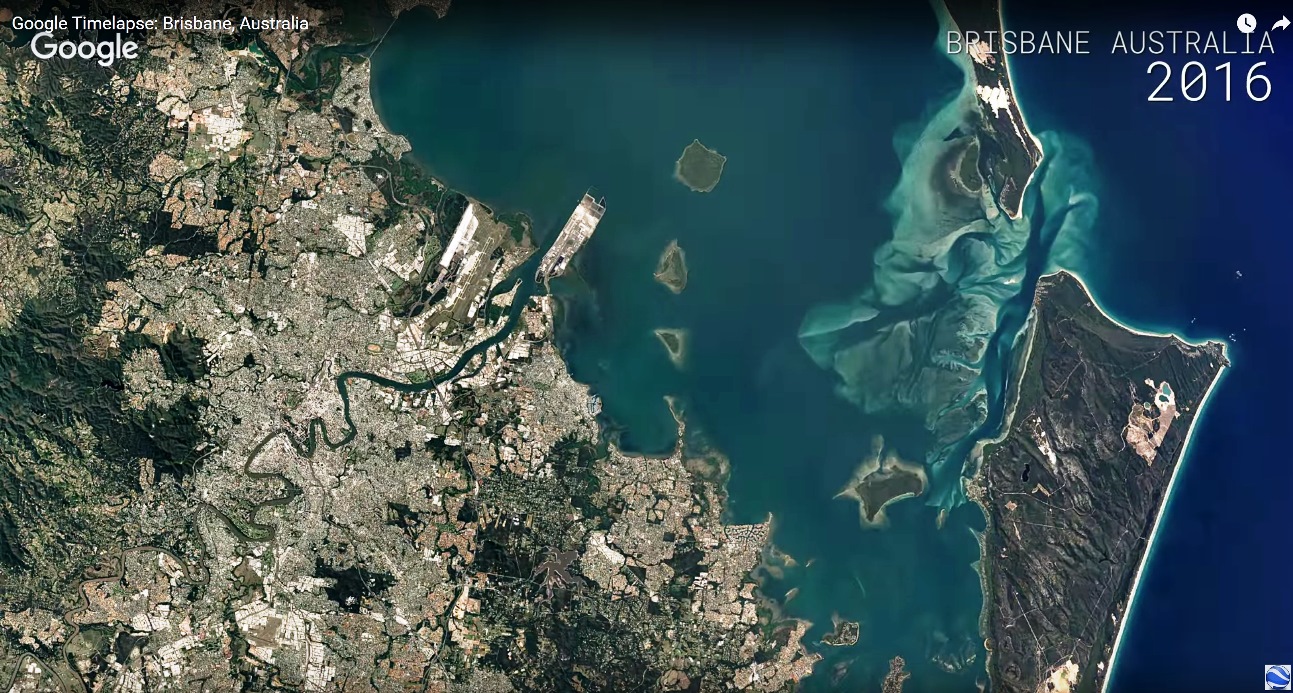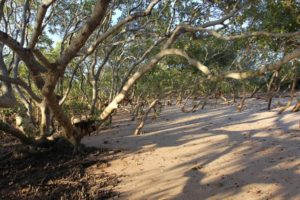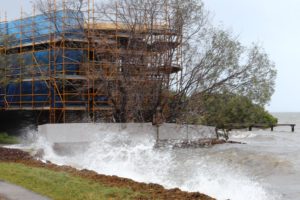

A google timelapse video shows how south east Queensland has changed in the past 32 years
The ShapingSEQ regional plan claims to have examined “megatrends” or “important pattern of social, economic or environmental activity that occurs at the intersection of many trends” .
Arguably the urban expansion of SEQ over the past 30 years is itself a megatrend… a trend to a 200km city which can be seen happening in a google timelapse video.
The Timelapse is a global, zoomable video that lets you see how the Earth has changed over the past 32 years.
Megatrends for ShapingSEQ (part 2)
Another perspective on mega trends comes from Sustainable Australia Report 2013: Conversations with the future provides a picture of Australia – what we look like and who we are. It tells the story of how we have changed as a nation over the last 30 years. Well worth a read.
In the context of ShapingSEQ in a previous post we examined the plans overview of Increased Urbanisation and New Technologies.
The gap between science and planning seems to be widening which the evidence based approach to planning is being replaced by a top down model (see Moreton Bay – 20 years of science and planning)
In this post we examine and comment on four more of the megatrends identified in ShapingSEQ ie
- Health, Ageing and Changing Preferences
- Resource Dependency
- Pressure on Biodiversity
- Climate Change and Disaster Resilience
Ways to make a submission/comment to the SEQ Planners are provided below.
Health, ageing and changing preferences

The old times look good in hindsight, 1936
This megatrend is as valid as any of the others. As the financial commitment to live in SEQ increases, the flexibility to change living standards with age declines. For example, if pensions do not advance as quickly as the SEQ economy and current downsizing of living conditions continues for the aged, then their flexibility to relocate to keep living standards stable can be expected to decline. Choice of healthcare regimes will suffer the same declines.
The advent of more of the aged people acquiring reverse mortgages will increase this sense of entrapment and dependency. This lessening horizon will see pressure to more rigidly stratify urban society into those advancing villages and those just able to survive with a constant fear of losing community antonym.
The plan’s idea to integrate village-type centres to allow for more uniqueness within social communities is laudable but it is not demonstrated elsewhere. What is the likelihood for some of these villages to be identified as aged communities and thereby become lesser places in the overall economic scheme of things? This can engender a segregated social landscape rather than the desirable more integrated society.
As regards changing preferences it is not clear that change is within the lexicon of the planners when pertaining to the aged. Perhaps in 25 to 50 years, one’s sense of self will be less related to their careers and financial resources. More self-awareness will be focused towards their social class when an individual’s change in status will be more readily accepted and deemed less threatening to their community status.
At that time aged communities may well accept structural social change as normal. It seems that the current aged community are unable to accept economic class as their delineating qualifier at least in the foreseeable future.
The concept of a village can be construed as a balanced social order where family status is used to hold the village together and allow for more streamlines social services to have common outcomes – perhaps a “well being” index can standardise this desired status.
As time evolves and the community ages these common indices will change because the social structures they reside in will have changed. These community personalities will not develop uniformly and social inequity shared between the various “villages” will lead to an advantaged or disadvantaged community matrix to evolve.
In an urban context this leads to a perpetual renewal processes with the goal of stable community living being realised. But since renewal requires public revenues the local resident’s well-being can be expected to degrade, as did public housing developments experienced decades ago.
Therefore, the intent of the “plan” might be to have a social scale that is community based and beneficial. Yet there is difficulty in seeing how these intra-urban personalities can be stabilise enough to make for tight self-supporting communities where change is understood to be mandatory. Even though community wellbeing is best achieved with social stability. The fear is that the village model will reinforce a stratifying force that will see stable aged communities as lower income and economically static centres with declining standards of living.
Overall, inequality in Australia has risen over the last 40 years and is a very genuine megatrend!
Resource dependency

Arable land in the Redlands is disappearing
This megatrend requires complex understanding and management regardless of the plan’s scope. Yet it is the most difficult trend to quantify.
For example, as waste management systems improve the level of recycling will increase. In 25 years it can be expected that fossil fuels will be for the World’s disadvantaged and that renewable energy will predominate in modern societies.
The advent of significant climate change in SEQ, whether it is longitudinal or cyclic, can expect to make natural resources ever more limited. Conservation measures in freshwater reserves will see progressively more marine sources used.
As “alternative” energy resources become more available the extraordinary costly access to desalinise freshwater will lessen or just become less argumentative as water’s value increases. This dependency is of a lesser concern.
Arable land to produce foodstuffs will become more limited too and be more intensely cultivated. There are some that already claim the planet has only 60 years of arable soil remaining (ie sufficient to feed the human population). It can be expected that while the natural environment will be more valuable and kept as a spiritual measure of human development, arable land will take on a more industrial management structure for food production to meet demand.
SEQ can expect this demand to increase owing to its climatic desirability and easy access to energy for cooling purposes. Population growth through immigration will likely persist…without a proper benefit cost analysis.
The position fostered in the “plan” would have us believe that biodiversity is in of itself justified for conservation purposes. After reasonable positions for water and lands being achieved, this stance is confusing. To assume that biodiversity will be stable whilst the environment of SEQ radically changes is difficult to understand.
In 2016 we are presented with a presumption of having an unintegrated ecological matrix for SEQ’s environment. If the megatrend for technological change is presented with so much promise how can we accept that the ecology SEQ physically resides within, can be maintained unchanged?
Pressure on biodiversity

Mangroves are a key part of biodiversity in SEQ
The presumption in the plan is that “biodiversity” is identified as merely wildlife preservation. This definition needs to change to encompass more than just an entertainment connotation.
Biodiversity needs to be seen in the context of being environmental stabilisers able to modulate expected climate changes.
Human well-being is dependent on these modulators. Vegetation to modulate flooding in SEQ is one very easily understood economic reality.
As taxation revenues wanes from ever more costly storm impact expenses and infrastructure repairs become ever more costly, more reliance will be placed upon biodiversity’s modulating affects. This means whole environments will need to be healthy from soil microbes to forest cover.
Why is so little presented in the “plan” about this biodiversity dependence. The loss of soil stability can strip governmental coffers of funds more quickly than storm repairs yet nothing is expressed within the “plan” to rearrange fiscal budgets to protecting these low cost environmental stabilisers.
It seems that the “plan” spends too much time on preserving the tokenism of biodiversity and not enough on the preservation of that biodiversity’s stabilising effects in the SEQ environment. A fulsome move to an ecosystem services approach to planning is warranted, the current focus on urban development, growth management and traditional employment will prove inadequate within the timespan of the Plan.
The ironic fact is that the ecological complexity of the current SEQ biodiversity portfolio is too great to replicate when it is altered or lost. For instance, those trophic pathways regulating our environment may actually be able to evolve with current rates of climate change so keeping SEQ’s environment healthier.
However to impair this ability of the environment to evolve can have profound impacts on future environmental health. Having more reserves and parks has little effect on this scale of required stability in SEQ’s biodiversity.
The SEQ climate is one of the resource dependencies not considered in the “plan”. This shallow expression of resources dependency needs some qualified attention.
Climate change and disaster resilience

Planning for severe weather events could be a growth industry for SEQ
As with most climate change discussions currently underway, a lot of attention is being paid to the sense of preservation. Yet little is presented to see if there is any social benefits to be had from these projected changes.
It is suggested that because climate change is and will continue to be impacting on the development of SEQ that less emphasis be spent on remediation pursuits and more energy put into pre-empting change to benefit the SEQ community, even if it is considered on only a temporal scale.
If we are looking for more employment, higher skilled public service employment at that, fostering a new climate change industry that offers income-generating jobs might be a better option than merely working on patching up extant SEQ infrastructure damaged by climate change.
Planning for severe weather events could be a growth industry for SEQ. Further SEQ could be the centre for exporting these skills regionally and internationally. Clearly, the “plan” should move away from solely fostering insurance-based programs. Instead to organise an industrial program that markets climate change for earnings.
Of course there is now need to consider the known knowns or the known unknowns that will flow from the views of the new American President, Donald Trump…he may well be the unforeseen megatrend.
Make a submission to the SEQ Regional Plan
Submissions must be provided to the Department of Infrastructure, Local Government and Planning in writing and include the following information for all submitters:
• first and last names
• addresses (home or business)
• signatures (unless lodged electronically).
Submissions may be lodged several ways:
• Online: Lodge your submission
• Email: SEQRegionalPlan@dilgp.qld.gov.au
• Post/ mail: Draft South East Queensland Regional Plan Review Feedback, Department of Infrastructure, Local Government and Planning, PO Box 15009, City East QLD 4000.
Collating a submission
Perhaps some people or groups would like to make one liner of specific issue submissions and make these available to other people or organisations. On this premise, Redlands2030 invites comments to this and other posts which might be collated into a coverall submission. This submission will be published and anyone will be able to submit all or part of the collated submission for input to ShapingSEQ.
To support a collated submission add a comment to this or the related posts (noting some posts have been published e.g. New SEQ Regional Plan Developed in a Vacuum , Moreton Bay – 20 years of science and planning and more will follow).
Redlands2030 – 19 December 2016
Please note: Offensive or off-topic comments will be deleted. If offended by any published comment please email thereporter@redlands2030.net
4 Comments
Oh dear oh dear the Political parties, vested interests and an out of touch Mayor and councillors are off with their own interests again (sigh).
The first Lord Acton coined the wisdom “power tends to corrupt and absolute power tends to corrupt absolutely”
The problem here is that all of the above have assumed a power they logically have no right to. and have extended their representative election to mean the right to rule. Thus unleashing all manner of undemocratically endorsed idiotologies [sic] and self interests. Then justifying them with well post truth ( read lies) reasoning.
For example who elected the developers in to office hmm. ( they are a minority any way you cut it) likewise ‘old power’ read ex farmers/ land owners are now a minority of the public but they through various relationships wield undemocratic power.
Yes the retired farmers have a right to sell their land ( their super?) but ask yourself who else has a super fund that runs into the $millions politicians etc. What is in fact happening is Land Speculation and like all business activities doesn’t have a right to unduly influence the govenance . Ask yourself when was the last time you saw small speckie builders competing (competition keeps prices low)? What we have is a limited core of big developers in the Redlands who often use options and pump the land prices higher than the competing speckies can’t compete . The developers can ‘bank land’ hold it back to inflate the price to cover their interest . The result is houses on blocks that remind me of the old song. ” The hills are full houses in a row and all full of ticky tack and all look the same” one commenter to, the paper called it ‘Brick Venereal Disease’.
If there is one thing that used to typify the Redlands was that it wasn’t another Ipswich or Logan .
What the state planners ( all the others are simply interested in getting elected or their careers and screw everyone/ everything else). One should look very closely at the relationships between the councillors, the families, people they grew up with etc. the developers and the state representatives. How many of them are just average or unimportant power lite globules like me with no pre existing ties?
The problem next comes from the above peoples actual expertise at running a multi million organization in the interests of ALL people ( read voters) proportionately. Hence we have some very biased individuals in those jobs who serve a minority most of who don’t live here or will more away.
For the record when an elected member is sworn in the oath is to serve the people ( ALL of the voters) not just close relationships or businesses ( most of the latter don’t live in the Redlands and as is easily demonstrated aren’t the biggest employers of Redlanders nor do the benefits come to the wider Community of the Redlands. i.e. 40 houses by speckies would add infinitely more benefit to us than one major builder who source materials elsewhere and hires a core but their subbies are screwed down in their wages and can be from anywhere.
Sadly the council officers are only charged to advise the council if actions they want to put in train are legal with in the laws. Not whether they are wise or advised. Hence we come back to people who have no real training like a kindergarten or High school teachers both with strong family ties to other minority members.
Would you invest you life saving in a business that was ‘managed’ ( hmm) by people with such little relevant skills ? I wouldn’t!
Now the power lot in the first paragraph are running out of control. The state members are more concerned about their party or their own ticket on the gravy train. The government is not going to be swayed by a pile of protest letters or comments . The latter will be measured by do they point to something being illegal? no then expect no action. The Labor govt know this is a Conservative area so they won’t win enough votes to change their future so who cares. So I would implement another strategy one that would make the LNP and Labor reconsider. What? well I never telegraph my punches.
The author has nailed down most of the Biodiversity parameters . However we are in the McPherson Macleay Overlap with NE NSW and more Biodiversity attributes deserve attention for submissions on the Plan .
There are many other components to Soil Health, Water, Ecosystem Services, while Fauna and Invertebrates need other Articles.
While we do not have a State of the Region Report, there are other documents out there besides the Moreton Bay Documents. Some public servants would know of more but some of these include: 1. The SEQ NRM Plan and Atlas featuring Targets and Ecosystem Services still waits for Ministerial or Government Approval. There are a suite of in house environmental reports by SEQ Catchments unpublished, also in EHP (Back on track , koalas etc)
2. The SEQBioregion Biodiversity Planning Report 2016 is another formidable Report. However it is as only as good as the field work and lacks necessary Legislation to stop or mitigateVMA, SPA, SARA , EDQ and Coordinator General ,DTMR and Qld Treasury(Ports etc) .
3. The Qld State of Environment Report 2016 is now electronic, lacks hard copy and you guessed lacks a SEQ Chapter.
The components of Biodiversity also need add ons of Indigenous Heritage and Social Surveys. The Vegetation has several reporting arms, DSITIA ;SLATs (landclearing) and Qld Herbarium Maps and Documents , DNR -PMAVs, Mapping, DEHP other items under EPAct(Essential Habitat MSES) and Marine Vegetation is another
The Qld SOE 2016 states “There is no established program for mapping condition of vegetation on a regional basis in Queensland”. This is disturbing for SEQ, and Leasehold elsewhere under the Lands Act.
Finding out what is happening to fauna across the Nature Conservation Act and a string of agencies is challenging but there is a general loss of numbers across most classes, and increase in Threatened Species for a multitude of reasons.
There are a string of 5 poorly funded programs documented in the Qld SOE which by inspection and local knowledge deserve independent , scientific and other review.
A. Landscape Fragmentation Connectivity Tool. This is possibly not used for linking Shrinking Koala populations, separated koala genome populations, or hemmed in macropod populations in Ipswich, Sunshine Coast , Logan and Redlands, but has been used for Bioregional Corridors.
B. Strategic Fire Management Program. Many other Fire Documents exist at 3 levels of Government and are not available. These need comparison with “Micro Mosaic Burning” (Sands, D.R. and Hosking)
C. Biocondition. Some work has been undertaken on over 300 Regional Ecosystems of say 1350.
D. Strategic Pest Management . The predation on small to medium ground mammals is unsustainable, with “super cats”, foxes and pigs on the rise.
E. Offsets Act 2014. The State Offset Register does not pick up; regrowth clearing( koala habitat), most urban and PDA clearing. The Offsets system remains unsustainable across 3 levels of Government .
F. Threatened Species. Across 3 levels of Government there are notifications and registers but little funding and enforcement and Habitat buyback.
The review and failure of these and other programs to redress biodiversity decline should be part of the response on Biodiversity and the draft SEQ Regional plan
The Indigenous Heritage warrants better identification and education with occupation sites, trees , bora rings ,pathways and other prominent and sacred sites in the landscape, before they go under the bulldozer. North Stradbroke Island features unusual sites . The Coastal Mainland sites can be often found near riparian zones, anabranches or permanent water or geological features. Some of these now slip into the periurban advance of , SDAs, RLA s and PFGAs and associated infrastructure. Few clans have Keeping Places for artifacts. See the Macquarie Atlas of Indigenous Australia by Bill Arthur and Frances Morphy 2005 for some cultural background.
So the threats to Biodiversity line up as Climate Change versus the trioka of institutional threats, development threats and real time environmental threats(fire , ferals.drought)
The Protections are on balance ,not there in the draft Plan or SPRP or SPP or new Planning Act etc.
So Biodiversity as part of the urban fabric (say 79,000ha of 350,000ha- still work in progress ), warrants protection, for its functional services (E.S.)as well as its iconic and other attractions.
The periurban areas containing considerable biodiversity and residents are just a plaything for developers and governments.
Liveability is on the downward slide,lined up against many SEQ NRM and other targets
Harry
The mega trends may be real enough…the regional plans response is like a fairy tale…we will all live happily ever after. Minister Trad will go down in the history books as perhaps the worst planning minister…since Hinze.
The Shaping SEQ has left out so much of what was previously regional issues and dumbed it all down in a way that her tribe of young and underdone planners can cope. The meet the planner sessions were supposed to be about questions of the planners it quickly became a note taking exercise by the planners. But the notes were not made available to the source…so where does all that reporting end up….in the bin is the only feasible destination.
The mega trends go no where in the plan…it will deliver more and more of the same…except smaller lots, more congestion and a depreciated lifestyle.
Wake up Jackie, the ship looks like it is out of control….but maybe you know that!
The megatrend issues are challenging and if these and the thought bubble issues , some without Planning Principles and bodies of work , are to be forced into Regional Planning , then there are more reasons to keep the Desired Regional Outcomes, the Strategies, Narratives , Value Sets and Programs which have been temporarily excommunicated.
Missing Megatrends are the myths generated by media,governments and development
industry such as balanced development , you can’t stop development, high rise is protecting bushland … This is affordable housing , Offsets are feasible/mandatory . while Councils won’t buy or accept greenspace (just take the $ and hide it).
The other Mega trend is CODE development . Put your complaint in to DILGP about Development Assessment Rules and new jargon on types of assessment . The Planning Environment Act 1990-97 had Town Planning Consent Use -advertise , object and appeal . Reclaim this as your right to contest the new “Missing Middle” -1-6 Storeys in the draft SEQ Regional Plan -NEW ASSESSMENT where impact Assessment does not apply .
There are also Social Planning Components , climate science , Biodiversity issues and complexities and other innovations which are not entering pilot studies , being discussed , embedded in policy or defined in law or Planning in Queensland perhaps Australia, and not in the SEQRegional Plan .
The loss of thousands of Scientists and Environmental and Planning Staff in Redlands & other Councils , EHP and 4 other State Agencies and Federally with Federal Environment Department (600) and previously from close down of Threatened Species, Land and Water and Climate Science Departments and finally CSIRO(300+) is not sustainable for livability , economics or the environment.
The Minister Jackie Trad has indicated that a Strategic Impact Study (Environmental) will be undertaken for South East Qld in the next 2 years under the federal EPBC Act. The EPBC Act has not delivered on saving SEQ Koalas or landscapes in megadevelopments, megaroads or about 7 PDAs. Biodiversity Hotspots are not being identified and protected at Mt Cotton, Eprapah Creek, Sunshine Coast Lowlands , Chambers Flat wetlands and aquifer , Logan South Preferred Future Growth Area, Undullah , Bahrs Scrub and Dry Scrubs and as we speak 410 ha bushland and Bioregional Corridor is threatened by Mirvac at Greenbank East PDA , all in SEQ. The staff and legal access ,framework and intent, are not there to do the SIA or good fauna and invertebrates and Archeology Studies. Why sign off on another Canberra top down process/delegated desk top process to the cheapest consultant ,to fast track more development ,when these Biodiversity Hotspots and others are not identified or protected?
The 200 kilometre city seems to have crept out to 250 kilometres and the koalas in northern NSW
appear to be perhaps facing greater extinction threats than SEQ koalas according to the latest Australians for Animals newsletter.
The outcomes for “deplorable” Planning and Environmental Laws appear to have retreated back to the Eighties, but there is less environment left on the coastal lowlands.
There are Institutions and organisations to retread the 2009 SEQRegional Plan attributes and find ways to get these and the NRM PLan and other Social Planning , Liveability, Climate and Biodiversity endeavours into the SEQ Regional Plan